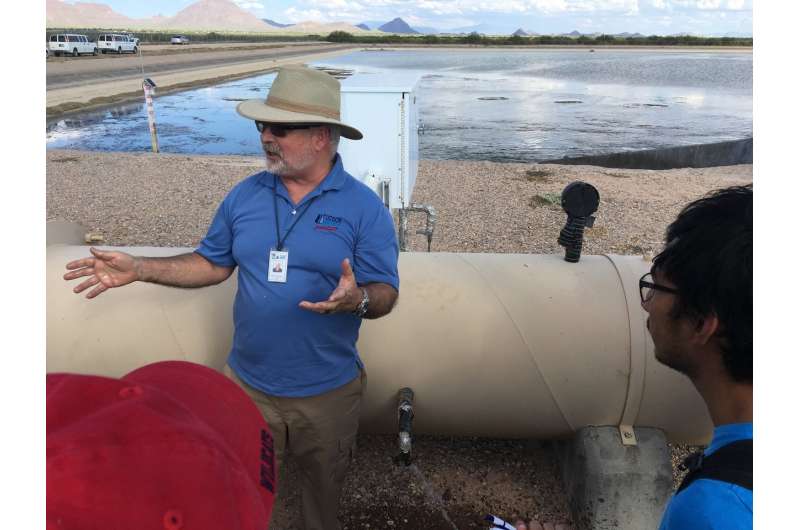Groundwater recharge in the American west under climate change

Groundwater recharge in the Western U.S. will change as the climate warms—the dry southern regions will have less and the northern regions will have more, a University of Arizona-led research team reports.
"Our study asked what will be the effect of climate change on groundwater recharge in the Western U.S. in the near future, 2021-2050, and the far future, 2070-2100," said first author Rewati Niraula. The research was part of his doctoral work in the UA Department of Hydrology and Atmospheric Sciences.
The new study covers the entire U.S. West, from the High Plains states to the Pacific coast, and provides the first detailed look at how groundwater recharge may change as the climate changes, said senior author Thomas Meixner, UA professor and associate department head of hydrology and atmospheric sciences.
"For the southern region of the Western U.S. there will be a reduction in groundwater recharge, and in the northern region of the Western U.S. we will have an increase," said Niraula, now a senior research associate at the Texas Institute of Applied Environmental Research at Tarleton State University in Stephenville, Texas.
Groundwater is an important source of freshwater, particularly in the West, and is often used to make up for the lack of surface water during droughts, the authors note. In many areas of the West, groundwater pumping currently exceeds the amount of groundwater recharge.
"The portions of the West that are already stretched in terms of water resources—Arizona, New Mexico, the High Plains of Texas, the southern Central Valley—for those places that are already having problems, climate change is going to tighten the screws," Meixner said.
Niraula said, "2021 is pretty close, so we need to start acting now. At the individual level and water-manager level there are many things we can do."
The researchers tested how future precipitation and temperature projections would interact with aspects of the land surface such as vegetation and soil type to affect groundwater recharge during two time intervals: 2021-2050 and 2071-2100.
Although generally the dry areas are going to get drier and the wet areas will get wetter under climate change, the new research indicates that future changes in groundwater recharge are more complex.
"Changes in recharge don't necessarily map onto changes in precipitation even at a very local scale," Meixner said. "The geology and the ecology of the landscape have an effect."
The paper, "How Might Recharge Change Under Projected Climate Change in the Western U.S.?" posted online in Geophysical Research Letters in October. A list of the authors is at the bottom of this release. The U.S. Geological Survey's John Wesley Powell Center and the National Science Foundation funded the research.
Because the various climatic regimes in the West will affect recharge differently, the team divided the West into five hydro-climatic regions: south (Texas, Oklahoma and Kansas), southwest (Utah, Colorado, Arizona and New Mexico), west (California and Nevada), northwest (Washington, Oregon and Idaho), and the northern Rockies and Plains states (Montana, Wyoming, North Dakota, South Dakota and Nebraska).
To estimate groundwater recharge for the baseline period of 1971-2000, the researchers used a model known as VIC (Variable Infiltration Capacity). Information from VIC is available for the entire coterminous U.S. on a grid of about 7.5 miles (12 km) on a side.
In addition to temperature and precipitation, VIC's groundwater recharge estimates take into consideration a particular location's land surface, vegetation and soil type. Those factors influence whether water on the landscape evaporates, runs off or soaks into the ground and recharges the aquifer.
For projections of future temperature and precipitation during the near future (2021-2050) and the far future (2071-2100), the researchers used 11 different global climate models. The scientists then plugged the future climate estimates from each of the 11 models into the VIC model to generate projected groundwater recharge scenarios.
For each region and time period, the researchers compared the projected groundwater recharge with the recharge during 1971-2000.
For the near future, the majority of models projected that recharge will increase in the northern Rockies and Plains region. The models agreed that groundwater recharge would decrease for the west and southwest regions. For the south and northwest regions, the projections were more uncertain and decreased and increased, respectively.
The difference among the recharge projections from the 11 global change models reflects the difference in future regional precipitation that the models project, the authors write.
This new research provides a broad picture of how climate change may alter groundwater recharge in the future, Meixner said.
"Groundwater represents a bank. We can store water from decade to decade, and arguably millennium to millennium—but when we take a withdrawal from that bank, we have to hope there are deposits making up for our withdrawal," Meixner said. "If there aren't deposits making up for the withdrawals, we have less water in the future to face water resource challenges with."
Managing groundwater now and in the future is the role of management and policy, Meixner said.
"The future is saying there's going to be less recharge. That doesn't mean you drain the aquifers dry," Meixner said. "Whether we drain the aquifers dry is a management decision."
More information: R. Niraula et al, How Might Recharge Change Under Projected Climate Change in the Western U.S.?, Geophysical Research Letters (2017). DOI: 10.1002/2017GL075421
Journal information: Geophysical Research Letters
Provided by University of Arizona




















